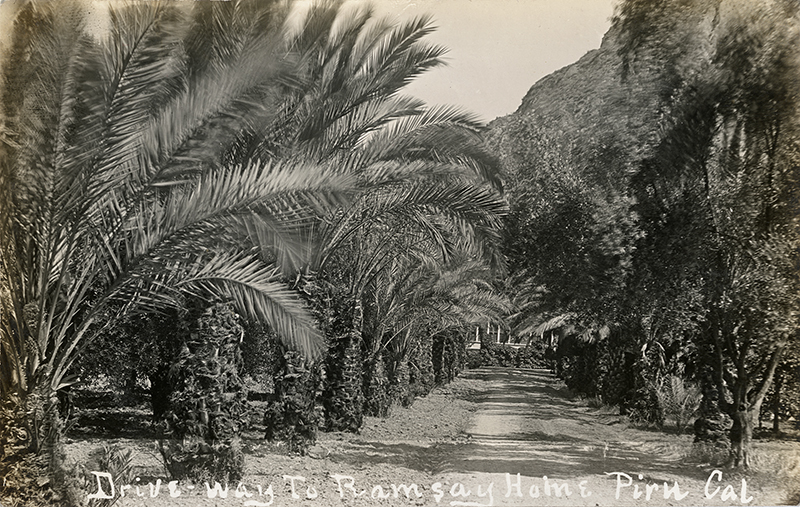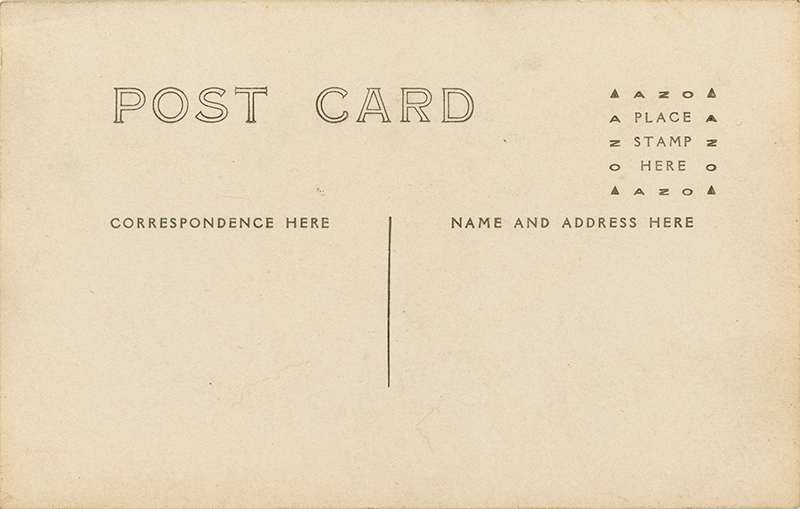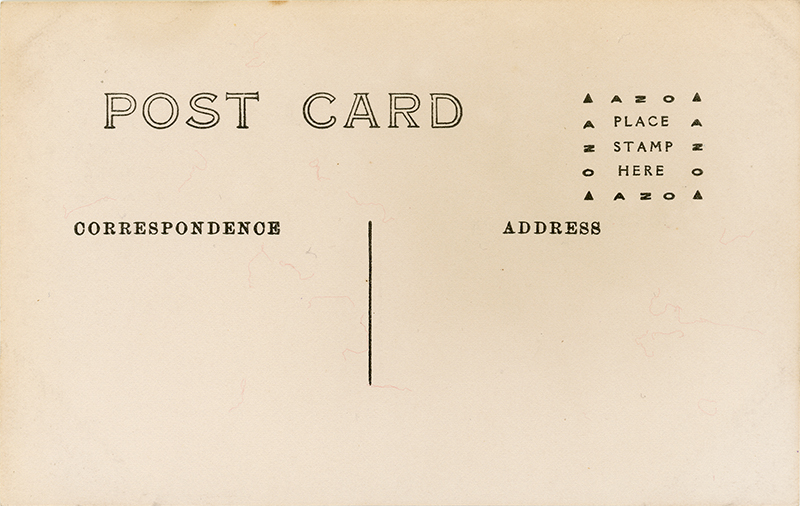Driveway to Piru Mansion
Piru, California

Click image to enlarge
| Download archival scan
Palm tree-lined driveway to the Piru mansion, 2 similar views, circa 1910 (1907-1911). Rare. Both of these real-photo postcards are undated. From the stamp box on the back — "AZO" (name of a silver chloride photo paper by Eastman Kodak), with four arrows pointing up — we know both were printed between 1904 and 1918.[1] The RPPC above identifies the view as "Drive-way to Ramsay Home, Piru, Cal."
"Ramsay" was William A. Ramsay, a millionaire from Colorado and Los Angeles who owned the mansion from 1907 to 1911 — which narrows the date of at least the first image shown here. The mansion was built on order of David C. Cook, a Methodist publisher of religious tracts from Elgin, Illinois. Cook purchased 14,700 acres of Rancho Temescal, which had been granted to gold finder Francisco López in 1843, and built the town of Piru within it. By some accounts, Cook built the mansion at a cost of $30,000 (as well as a train depot and church) between 1886 and 1890; others say it was built between 1887 and Christmas Day, 1892, when 100 people attended a housewarming party.[2] Cook remained in Illinois and hired W.H. Fleet to superintend the ranch. Fleet lived next door to the mansion. Ironically, Cook would relocate to California for his health in 1901 after he had already sold the ranch — which he did in 1900 to the fledgling Piru Land and Oil Company (alternately Piru Oil & Land). Presumably the mansion became a company house at this time. In 1907, W.A. Ramsay purchased the mansion for a 4-figure amount that is illegible in an archived copy of the Los Angeles Times[3], but which might be $5,000. The Times tells us:
It is reported that W.A. Ramsey [sic], the Colorado Springs millionaire and electric road builder, has purchased the Cook mansion at Piru paying therefor $?,000. ... Mr. Ramsey, who is behind the scheme to build an electric road to the Ojai and the Matilija, has also secured an option on the Myers hot springs property in the Matilija, a valuable holding, and will further develop the place and exploit it in connection with the road.
An electric road is essentially a streetcar system. The distance from the Ojai gold fields to Matilija Hot Springs was five miles. Venture capitalists and their dreams of a scenic electric railway came and went. The only completed line, in 1905, ran from Oxnard to Hueneme.[4] Mr. Ramsay had made his fortune in the gold fields, but not in a traditional way. He was the private secretary to Winfield Scott "W.S." Stratton, the "Mining King of Colorado." In 1894, Stratton had become the Cripple Creek Mining District's first millionaire through his wildly successful "Stratton's Independence" gold mine, which he sold in 1900 through a broker in London. Under the banner headline, "Millionaires of Cripple Creek," the Los Angeles Herald recalls in 1902[5]:
Mr. Stratton was a very rich man at the time [of the sale] and Ramsay conducted the negotiations on Mr. Stratton's part. The mine was sold for $11,000,000, and was the largest sale for an American mine ever floated abroad. He [Ramsay] received his reward for this labor, and has an established reputation among financial men in consequence. Last year he parted company with Mr. Stratton and is now taking a much needed rest at his home in Los Angeles. A few years ago Mr. Ramsay was a poor accountant.
This poor accountant had organized Stratton's holdings into the Stratton Cripple Creek Mining and Development Company to facilitate the sale.[6] Even now, Ramsay didn't rest on his laurels. Stratton died in 1902; in 1904, Ramsay and partners formed a company to develop some gold mining claims near Last Chance in Placer County.[7] In 1907, with different partners, he co-founded the L.A.-based International Mines Corp. to mine for gold in Tucson.[8] Some months later, the Ramsay family moved into the Piru mansion. A one-line notice in the Los Angeles Herald in 1908 reads[9]: "Mr. and Mrs. Franklin T. Woods and Mr. and Mrs. S.S. Shepard have returned from a motor trip to Piru, Ventura county, where they were guests for a week of Mr. and Mrs. William A. Ramsay." Within three years, the restless W.A. Ramsay moved on. A trust deed was recorded in Ventura County on February 23, 1911, transfering ownership from one William A. Ramsay to the escrow company (Ticor). Unfortunately, the buyer is not identified in the notice of sale published in the Daily Oxnard Courier.[10] Nor is the property address, so we can't be 100-percent certain it pertains to the mansion, but this is about the time Hugh Warring is known to have purchased it. The Ramsays and Warrings knew each other; several reports in the Oxnard newspaper show that a Ramsay and a Warring played together on the same Fillmore baseball team. A half-century later, the Warrings sold the mansion to Scott and Ruth Newhall. Local historian Lauren Parker contributed to this story. — Leon Worden 2020 1. Philatelist and postcard dealer Ron Playle, 1937-2018, Playle's Auctions, accessed 2020. 2. Ventura County Star, March 17, 1932. 3. October 19, 1907. 4. Triem 1985:111. 5. February 23, 1902. 6. Lamar Register, Colorado, August 1, 1900; and Grand Junction (Colo.) News, August 4, 1900. 7. Los Angeles Times, August 31, 1904. 8. Tucson Citizen, March 1, 1907. 9. July 3, 1908. 10. February 28, 1911.
LW3721: 9600 dpi jpeg from original RPPCs purchased 2020 by Leon Worden.
|




